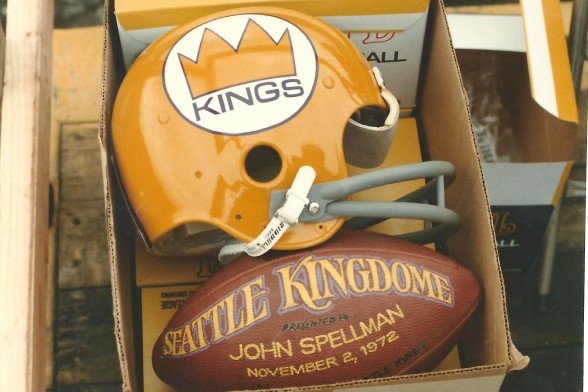
By David Eskenazi and Steve Rudman
On Aug. 20, 1955, Seattle played host to the first National Football League game in the city’s history, a preseason pairing of the New York Giants and San Francisco 49ers at Husky Stadium. Presented by Greater Seattle Inc., a clique of civic do-gooders who promoted the city to itself and the world beyond, the contest should not have carried meaning beyond the afternoon’s amusement. But it did, in a myriad of profound ways.
First, and due in part to the box-office bang provided by two former University of Washington legends, quarterback Don Heinrich of the Giants and running back Hugh McElhenny of the 49ers, the gridiron gala attracted 49,000 fans, the largest throng ever to witness a professional football game outside of an NFL city.
And considering that the turnstile count might have been even higher had not McElhenny been declared hors de combat due to injury 24 hours prior to kickoff, the day was deemed a major success. Seattle had landed squarely on the NFL’s radar for the first time, demonstrating that the city could, and probably would, support a new franchise — when the league next expanded.
Second, proceeds from the game, and the eventual misuse of them, placed the University of Washington on the NCAA’s radar.
One year after Heinrich completed 12 of 25 passes for 178 yards and a touchdown in New York’s 28-17 victory, the NCAA slapped UW with a two-year probation for condoning a secret fund to pay the school’s football players more than they were entitled to earn under terms of their scholarships.
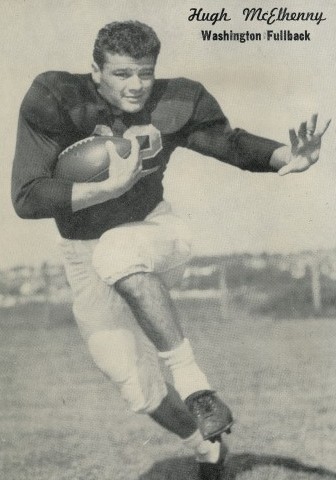
The fund, laundered from Greater Seattle Inc. into the coffers of the Washington Advertising Association, another downtown booster group whose talons dug deep into the UW athletic hide, had been established with proceeds from the Giants-49ers game (we will point out here, but draw no conclusion — ha! — from, the fact that Torchy Torrance, a UW alum and long-time school booster, served as president of Greater Seattle Inc., and also headed up the Washington Advertising Association). The revelation of its existence produced thunderous blowback.
Athletic Director Harvey Cassill fired football coach John Cherberg. In retaliation, Cherberg disclosed the existence of the slush fund. The UW forced Cassill’s resignation. To UW’s horror, Sports Illustrated pulled UW’s pants down around its ankles in a multi-page article for all the nation to see. Worse, the NCAA placed all UW athletic programs on probation for two years, a development that actually created at least one happy, historic footnote.
Banned from competing in the 1957-58 IRA championships, the men’s rowing team accepted an invitation to a 1958 race in Moscow, Russia, against the famed Trud Club. The Huskies shocked the Soviets in one of the greatest achievements in UW sports history (the first broadcast of a U.S. sports event behind the Iron Curtain), one that would not have occurred if its athletic teams hadn’t been on probation due to boosters run amok.
With Cassill ousted and now selling used cars, UW turned to 31-year-old George Briggs to clean up the mess. He replaced Cherberg with Darrell Royal, who coached one year (1955), then quit, but recommended Jim Owens as his replacement.
By 1961, Owens owned two Rose Bowl wins and had altered the course of West Coast football history. But by then, the Pacific Coast Conference, which dated to 1916, had collapsed, partially under the weight of the UW’s slush fund scandal.
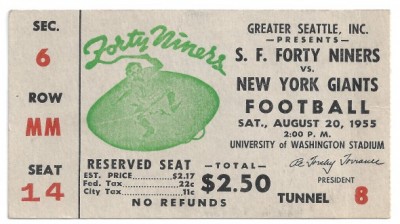
But bad doings at UW did not quell Seattle’s enthusiasm for pro football. Husky Stadium hosted eight additional exhibition games after the 1955 Giants-49ers match, each with varying degrees of fan support, but always with enough to remind the NFL that Seattle remained ripe territory. And the NFL, having created an opiate for the people, came to believe it could no longer deny it to those who could support the habit. All Seattle needed was a place for an expansion team to play.
Seattle restauranter Dave Cohn floated the first serious proposal for a major new domed stadium in 1959. The Seattle City Council rushed a $15 million bond issue onto the 1960 ballot, but voters were not ready to pay the price — especially with no guarantee Seattle would be awarded a professional franchise — in any sport.
That became the crux of the controversy. Although many local sports fans and business leaders supported the construction of a stadium — originally referred to as “King Street Stadium” — others were skeptical of its cost and impact on surrounding communities.
Minnesota GM Max Winter and Los Angeles Rams assistant GM Elroy “Crazylegs” Hirsch, representing the league, visited Seattle in 1966 to observe its NFL readiness, and hinted Seattle had become a strong contender for a franchise. Winter and Hirsch also explained the NFL’s procedure for expansion: it would select a city first, then accept applications for ownership of the franchise. With this information, King County placed a bond issue on the November ballot, but it failed again.
That prompted stadium boosters to join forces with the Forward Thrust regional improvement effort, just launched by civic leader James Ellis. Along with several other projects, voters approved $40 million in bonds for a new King County Multipurpose Domed Stadium on Feb. 13, 1968, a development that not only made it possible for Seattle to host professional football, but satisfied Major League Baseball’s requirement for a new stadium (antiquated Sicks’ Stadium had no long-term value to the American League) for the Pilots, awarded to Seattle for the 1969 season (the Pilots were scheduled to play at Sicks’ Stadium until the domed stadium was finished).
Assurance that the stadium would be built resonated all the way to Minneapolis, where Twin Cities tycoon Wayne Field, who had always lusted for an NFL franchise, steered his sights toward Seattle, and took action. In February of 1969, he formed “Seattle Sea Lions Management Corp.”
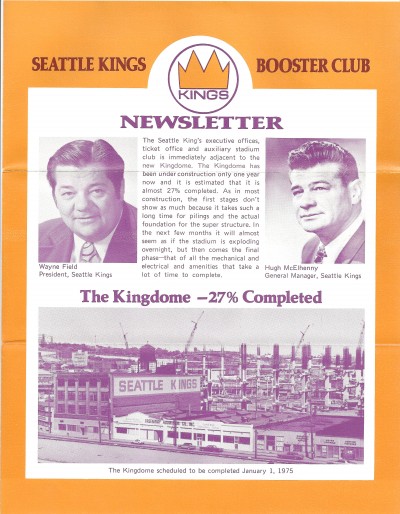
A world traveler and adventurer, Field boxed in the Gold Gloves program as a youth and sold Fuller brushes door-to-door to pay his college tuition. He campaigned for governor of Minnesota, served as president of the Minneapolis Jaycees, sat on a slew of boards, and championed just about every major fund-raising organization in the Twin Cities.
For his day job, Field had become wealthy as owner of the largest privately held assisted-living facility in his state, Heritage of Edina. Field had also formed more than two dozen corporations in nearly two dozen states, and represented precisely the kind of rich, do-good citizen the NFL sought in new franchise owners.
Field had one drawback: If the NFL moved into Seattle, Field would not be a local owner, virtually a league requirement. To counter the single flaw in an otherwise impeccable business/civic portfolio, Field sought to ally himself with the biggest football personality ever to emerge from Washington, Hugh McElhenny, then working for Allen & Dorward, an advertising firm in San Francisco.
Field had first laid eyes on McElhenny 22 years earlier, on Sept. 24, 1949, when McElhenny, then with the Huskies, returned a kickoff 96 yards for a touchdown in a game at the University of Minnesota.
Field saw him again in 1961 when McElhenny joined the Minnesota Vikings in the expansion draft. Field did not know McElhenny, who had left the Twin Cities after the 1962 season to finish out his NFL career with the New York Giants and Detroit Lions.
In a delicious twist, Field recruited Minneapolis acquaintance Bobby Cox to make the introduction. Born in Olympia, Cox had starred at quarterback at Walla Walla High. After rejecting a scholarship from the University of Minnesota that he nearly accepted, he cast his lot with the Huskies, explaining his decision years later: “The real reason I went to Washington is that they made me the best offer. Like a lot of other guys, I was just looking out for myself. I went to the school where I could get the best deal.”
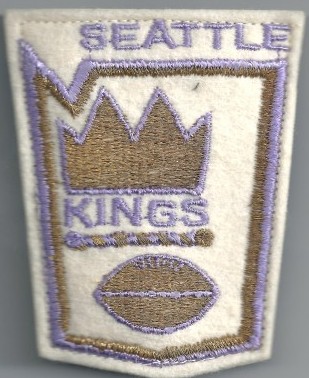
His time at Washington started out well enough. In one of the first games of his sophomore season, Cox threw three touchdown passes against a UCLA team en route to a No. 1 national ranking. But his tenure didn’t end well.
Disillusioned over dissension on the team and the growing slush fund scandal, Cox transferred to the University of Minnesota, where he made several All-America teams, got himself on the cover of Sports Illustrated (Nov. 4, 1957) and even orchestrated a win over the Huskies two years after bolting the UW program.
After Cox introduced Field to McElhenny, Field made the following pitch: Field would pay McElhenny $35,000 per year to leave his advertising job, move to Seattle and become vice-president and general manager of Seattle Sea Lions Management Corp.
McElhenny could own 10 percent of the Sea Lions (if the NFL granted an expansion franchise) if McElhenny made a $10,000 investment.
Or, McElhenny would receive three percent if he invested nothing. Fields would also bump McElhenny’s salary to $50,000 if the Seattle Sea Lions ever entered the NFL. Finally, Field would make a three-year commitment to the project and fund it with $100,000 annually. McElhenny liked the proposal immediately, but recognized the key issues would be the stadium and franchise entry fee.
McElhenny asked Field how much an NFL expansion franchise would cost, and Field guestimated $10 million, maybe less. The four previous teams to enter the NFL or AFL in 1965, 1966 and 1967 — Atlanta (NFL), New Orleans (NFL) and Miami (AFL) — did so for less than $9 million.
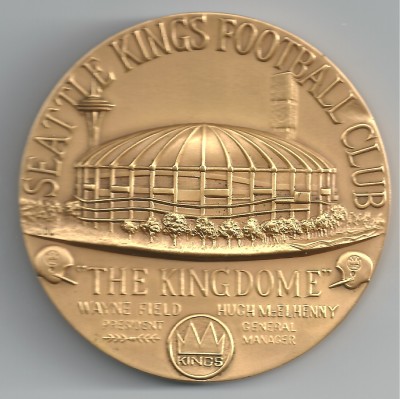
Cincinnati, a new AFL team in 1970, came in at $7.5 million, but received no immediate cut of the league’s TV swag, as the Falcons and Saints had ($2 million annually).
McElhenny accepted the job offer. He had wanted to return to pro football — and to Seattle — ever since his retirement in 1964, but no opportunity had presented itself. Now, he would become the face of a franchise almost certain to be awarded to Seattle, and a part owner.
He had the perfect face: the best UW football player ever, he knew everybody in pro football worth knowing, and could get a meeting with anyone on his reputation alone. Plus, he was still a flavor of the month, having just been elected to the Pro Football Hall of Fame.
McElhenny signed a three-year contract with Field on Dec. 17,1971, moved back to Seattle, set up shop in the Sea-First Building, and announced to the media, “This is a definite go. By the middle of next week we’ll be ready to reveal all of the people who will make up the team.”
The team ultimately consisted of Field and McElhenny; Spokane lumberman Ed Justice; William Hunt of Portland, president of Georgia Pacific; state Lieutenant Governor John Cherberg, a former UW football coach; and Minneapolis-based investor Bert Cross, president of the finance committee of the 3-M Company. Under terms of the partnership, Field would own 51 percent of the Sea Lions, the others three to five percent each. McElhenny frequently joked, “I’m the only flunky in the organization.”
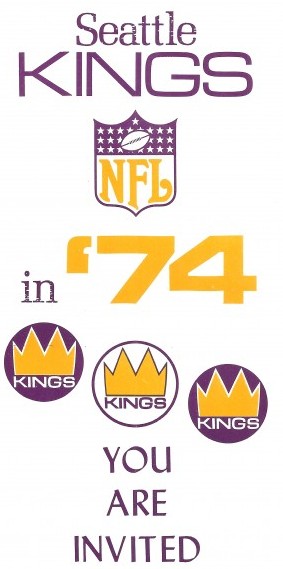
Late in 1971, Field and McElhenny decided to re-christen the Sea Lions “the Seattle Kings”, which they believed to be a more appropriate name given their discovery that the new domed stadium would be constructed in downtown Seattle, near the King Street Station.
Field immediately purchased the 48,000 square-foot Roebling Building (located just west of where Qwest Field stands today), spending $165,000 for it (plus $500,000 in renovations) to serve as the Kings’ headquarters and administrative offices.
In their various discussions with NFL officials, Field and McElhenny came to understand that four cities were under consideration for expansion franchises: Seattle, Tampa Bay, Memphis and Phoenix. The NFL would probably select two, giving the league 28 teams.
Anecdotal evidence, and some amount of gossip, also informed Field and McElhenny that Seattle ranked first on the NFL’s expansion list, and that the Kings would be selected as owners of the new franchise, if for no other reason than a lack of competitive suitors.
But Field and McElhenny took no chances. They promoted Seattle and the Kings relentlessly, here and around the nation, generating considerable media exposure. They formed a “Seattle Kings Booster Club” (which didn’t know if it would ever have a team for which to root) and wooed potential fans with an array of giveaways, including jacket patches and booster pins. Field and McElhenny also kept in touch with potential fans via newsletters, and staged a variety of high-profile events.
On March 22, 1973, for example, the Kings presented a “Pro Football Testimonial Dinner” at the Olympic Hotel to honor more than 200 professional football players from the Pacific Northwest. ABC-TV sportscaster Howard Cosell served as Master of Ceremonies, and each player received a commemorative medallion, specially commissioned for the occasion.
The Kings met constantly with officials from other NFL teams, and chummed the waters further by announcing in May, 1972, that the Kings would sponsor another exhibition to — once again — dramatize Seattle’s passion for the NFL.
The game would feature the New York Jets and Pittsburgh Steelers. Field and McElhenny chose the Jets and Steelers carefully in order to maximize the box office: The Jets employed one of the league’s top stars, Joe Namath, while the Steelers, with quarterback Terry Bradshaw, were a rising power. The Kings set the game for Saturday, Aug. 12, 1972, at Husky Stadium.
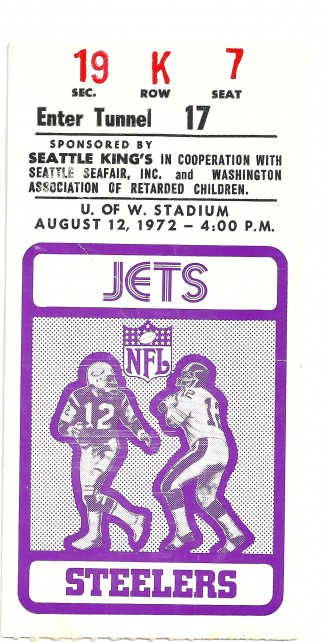
By now two conclusions seemed foregone: Seattle would be awarded a franchise, the only question being when, and the Kings, given Field’s promotional work and McElhenny’s profile, would be the owners — the only question being how much they would have to fork to the NFL for the privilege.
But a month later, in June of 1972, Field and McElhenny received a seismic jolt when a rival ownership group suddenly materialized. “Seattle Professional Football” included David Skinner, president of the Skinner Corp., and one of the original owners of the Space Needle; Howard S. Wright, a Seattle contractor and a majordomo in the Seattle World’s Fair; Herman Sarkowsky, a Seattle contractor who also owned the Portland Trail Blazers; Lamont Bean, president of Pay ‘n Save; Lynn Himmelman, chairman of the board of Western International Hotels and a trustee of the Seattle Art Museum; and Morris Alhadeff, president of the Washington Jockey Club (Longacres). Former Sonics GM Dick Vertlieb had been conscripted to serve in an advisory capacity.
Even McElhenny conceded that you would need to search dilligently to find a more representative cross section of the Seattle establishment than the men who made up Seattle Professional Football. The group was heavy with business success, family ties, civic achievement and personal prestige. Money? No problem.
Sarkowsky owned United Homes, one of the west coast’s largest home-building concerns. He had a life-long interest in sports (he had been sports editor of his school paper at Broadway High). He bred and raced thoroughbreds, and had purchased the Portland Blazers for $3.7 million in 1970.
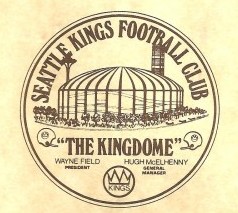
Sarkowsky quickly emerged as the spokesman for Seattle Professional Football, with the media predicting that if NFL Commissioner Pete Rozelle ultimately favored Sarkowsky’s group over Field-McElhenny, Sarkowsky would become majority owner.
However, in Sarkowsky’s first public comments, he said, “When we’re told the cost of the franchise, the terms of payment and so forth, we’ll determine the 51 percent owner.”
Sarkowsky also argued that Seattle Professional Football had a superior group of potential owners. “In our view,” he said, “we are better qualified (than the Kings) for an NFL franchise. But the NFL will judge which group is better for the city and the league.” Sarkowsky meant that his group featured only home-grown individuals, not absentee interlopers such as Field.
Asked about the rival group, McElhenny said, “Well, I wish them . . . no, I don’t wish them luck.” Added Field, “They’re trying to neutralize us.”
Field worked hard — and spent a bountiful sum — to counter criticism over his lack of Northwest roots. Following the Aug. 12, 1972 Jets-Steelers exhibition, which drew 44,027, the Kings gave $15,000 of the proceeds to a retarded-children’s charity and another $15,000 to Seafair.
To further cement the Kings as “Seattle based”, Field launched a company he called “Rembrandt of Seattle”. Two weeks after its incorporation, Field purchased the shares of one of the three principal stockholders in Seattle’s fast-growing PF Industries Inc., a 45-employee company founded by a couple of former Boeing engineers. PF Industries produced aircraft tools, and the stock purchase made Field the principal owner in the operation.
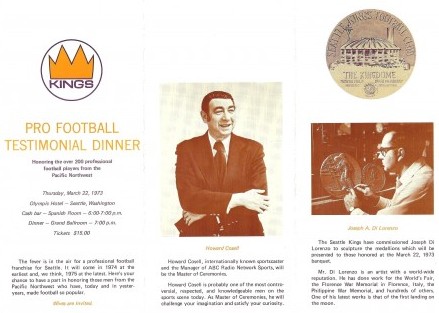
But some things Field couldn’t control. When the ownership of the Los Angeles Rams changed hands in 1972 for a price of $19 million, Field and McElhenny both knew that an expansion fee of $12-14 million was now possible. They hadn’t banked on such a rare sum.
Asked about the cost of expansion in the wake of the Rams’ sale, Sarkowsky said he believed “$12 to $14 million would be in the ballpark.” Pressed about the possibility of a $16 million expansion fee, Sarkowsky, said, “That would not be in the ballpark.”
Undeterred by the lack of a dollar figure, and operating under the notion that if you must know the price you have no business shopping, three additional groups popped up as potential owners.
Clarence Martin Jr., a Los Angeles businessman and son of the former Washington governor (Martin Stadium in Pullman is named after him), headed one. Martin Jr. had briefly held a minority stake in the Rams. Stan McDonald, head of Princess Cruises, expressed his interest, but played coy about the nature of his group. Walter Schoenfeld and Sam Schulman represented a fifth bidder.
Schoenfeld, vice president and director of the SuperSonics, had tried unsuccessfully to purchase the Miami Dolphins three years earlier (he would later become one of the first Mariners owners). He also had close ties to rival bidder Sarkowsky: they were partners in the ownership group of the new Seattle Sounders of the North American Soccer League.
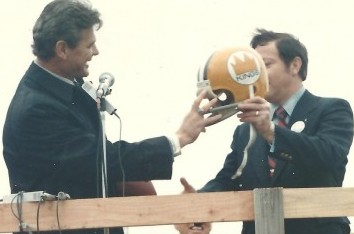
Schulman, owner of the Seattle SuperSonics, had once held an ownership stake in the San Diego Chargers. After his group — Schulman/Schoenfeld — became public, Schulman said he would immediately sell the Sonics if the NFL granted him a franchise.
To which Sarkowski added that he would immediately sell the Portland Trailblazers if the NFL granted his group a franchise (the NFL had a rule prohibiting cross-league ownership).
With new potential ownership groups emerging, Field/McElhenny felt it need to make another play, even though it had already run through a couple of hundred thousand dollars. So Field hired Ed Nixon, President Richard Nixon’s younger brother, and a 13-year Lynnwood resident. While Field stressed Ed Nixon’s business acumen, he could not overcome the perception that Nixon had been hired strictly to give the Kings an image goose.
Meanwhile, in an attempt to bolster the Kings’ claim to any future franchise, which once seemed to be a lock, McElhenny ordered NFL Properties, Inc., the league’s marketing/licensing arm whose profits were divided equally among the league’s 26 teams (and McElhenny’s only sports client when he worked in advertising in San Francisco), to design uniforms for the Kings. Before the year was out, McElhenny and Field paid visits to every NFL club, seeking their support.
On April 30, 1974, the NFL caught all ownership wannabes in Seattle off guard by awarding Tampa Bay an expansion franchise, not awarding Seattle one, and setting Tampa Bay’s expansion fee at $16 million, a price that made all the wannabes blanche.
For $16 million, Tampa Bay would receive an invitation to join the NFL lodge and be given the rights to pick up the contracts of a specified number of players from each of the 26 existing teams in an “expansion draft”. To ease the sticker shock, Tampa Bay would receive $2 million per year in TV revenues.
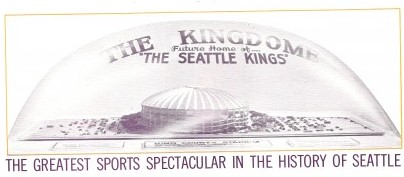
“We were disappointed that only one franchise was named”, said McElhenny, “and we found the $16 million shocking.” As to the NFL throwing potential owners the expansion draft bone, McElhenny said, “All you are going to get from the expansion draft is garbage.” McElhenny could probably be excused for forgetting that, in 1961, he had been acquired by the Vikings from San Francisco in an expansion draft to stock the Minnesota franchise.
It turned out that Seattle did not receive a team along with Tampa Bay because the NFL found King County’s stadium lease terms draconian (the Mariners would later discover the same thing, and that battle would rage for a decade).
But eventually, King County Executive John Spellman, who had considered threatening the NFL with the prospect of Seattle chasing a franchise in the new World Football League, reworked the fine print. On June 5, 1974, Seattle became the NFL’s 28th franchise.
But no one knew the identity of the owners, and for the Kings, the climate and economics had shifted — and deteriorated — dramatically.
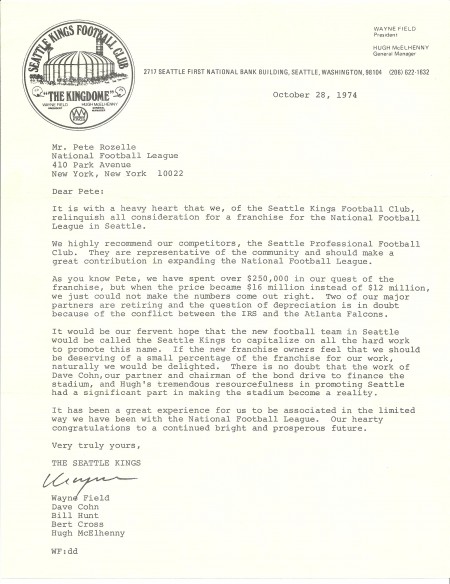
In addition to the far higher expansion fee (the NFL wanted it up front), the Kings had to consider the financial impact of a possible player lockout (owners, in fact, locked out players for 42 days in 1974), and what that might entail, and how the World Football League would impact player salaries (it had already poached a number of players at high prices).
Then there were the lawyers who drained each club through a spate of lawsuits, especially an on-going one involving the NFL’s TV blackout rule.
“All this hanging around and waiting has been difficult,” McElhenny told the media. “We’re going to continue to pursue the franchise. Wayne Field and I have discussed this. If someone else beats us out, they’ll just have to do one heck of a job.”
This is how the Kings sized up their situation: “We figure it would take $23 or $24 million to get started under those conditions,” said McElhenny. “You have to have plenty of operating capital to do well in building a team, or the investment will be lost. I’d hate to work without the money and hope that the gate catches up with the budget.”
Since the gamble was ultimately deemed too great that the gate would catch up with the budget, the Seattle Kings withdrew from expansion consideration on Oct. 29, 1974. McElhenny cited financial concerns and “excessive” demands by the NFLPA.
In a letter to Commissioner Pete Rozelle, Field wrote (displayed above), “It is with a heavy heart that we of the Seattle Kings Football Club relinquish all consideration for a franchise in the NFL in Seattle. We just cannot make the numbers work out.” Field then threw his support behind Seattle Professional Football.
Six weeks later, on Dec. 5, 1974, Rozelle awarded ownership of the Seattle franchise to Seattle Professional Football, announcing that Lloyd W. Nordstrom, representing the Nordstrom family, and not Herman Sarkowsky, would serve as majority partners.
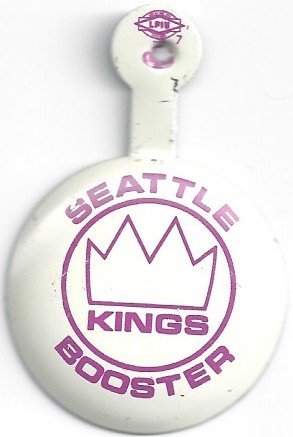
Field never did own an NFL team. After closing down the Kings, he returned to Minneapolis and worked his businesses. At age 80, he climbed Mt. Kilimanjaro for the second time, and became the oldest man to ride down Pike’s Peak on a bicycle. He also became such a proficient poet that he was nominated to serve as “Minnesota’s Poet Laureate.” He died in 2009 at age 87.
McElhenny thought he might have a shot at a front-office job with Seattle Professional Football, but it had no interest in him. It made John Thompson, then working for the NFL Management Council in New York, its first general manager. Ironically, Thompson had been the UW’s assistant sports information director when McElhenny played for the Huskies, and the Minnesota Vikings public relations director when McElhenny played for them.
McElhenny never did get back into professional football. He worked for a Seattle-based bottling company until he retired in 1995, then relocated to Henderson, NV., in ill health to take advantage of a drier climate. As for the Kings’ inability to land the franchise, and his own snub by Seattle Professional Football, McElhenny said, “That was a big disappointment in my life.”
Seattle Professional Football clearly read pro football’s tea leaves more accurately than Wayne Field. When the team began play in 1976, the top ticket price was $14. More than 24,000 season tickets were snapped up the first day they were available, and 59,000 had been sold within a month.
The franchise that Field couldn’t imagine penciling out financially is worth nearly $1 billion today. Field might have been short on cash, and maybe he botched the arithmetic, but his efforts — and McElhenny’s — went a long way toward establishing Seattle as a pro football town.
After Field threw his support behind Seattle Professional Football, he had one request: Given the five years of effort (and money) his company had invested in helping make pro football a reality in Seattle, would Seattle Professional Football (whose team would ultimately be nicknamed “Seahawks”) please consider naming the new team the “Kings”?
No, it would not.
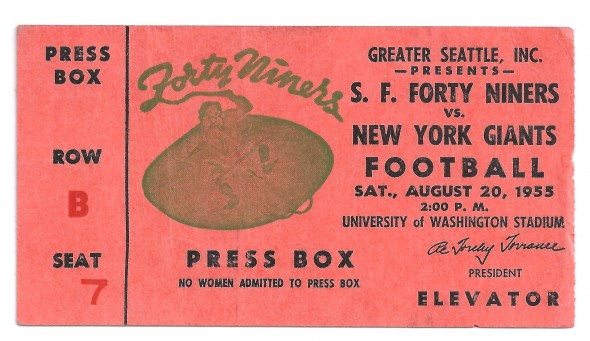
(Wayback Machine is published every Tuesday as part of Sportspress Northwests package of home-page features collectively titled, The Rotation.)

32 Comments
Great write-up. Field & McElhenney deserve recognition fir what they did, but it’s a good thing a cash-strapped ownership didn’t weigh down the club and region from the get-go. Not to mention the generic name, also best left on the shelf.
Thanks for reading!
I liked the article very much. Very interesting and even thought the ‘Best Man Won’ I appreciate the efforts of Fields and McElhenney.
Great article! Maybe the Seahawks could honor Field and McElhenney by wearing Kings uniforms someday. I enjoyed the images and I had no idea that Darrell Royal coached at Washington. A tremdous amount of effort for several years to land an NFL franchise should be honored.
Thanks
So that’s why it was named the Kingdome. Very interesting, thanks!
Great article. I used to tell my friends that I remember when the Seahawks were supposed to be called the Kings. They’d scoff and laugh at me, but I was absolutely certain. Well, the Kings and the ‘Hawks weren’t exactly the same team, but it’s nice to know that I didn’t imagine the “Seattle Kings.”
Thanks for reading and visiting our web site, Rob!
Thanks for the informative article & photos! My father took me to the August ’72 Jets vs. Steelers game when I was 9 (I still have the ticket stubs). Though my hero Joe Namath only played the first quarter, I was in football heaven that day at Husky Stadium. This story is a great reminder of what it took to actually bring an NFL team here to the Pacific Northwest. The late John Spellman deserves much credit as well.
great article on history of pro football in seattle .
Thanks for reading, Sean. We appreciate it.
Nice look back at the behind the scenes efforts to bring the NFL to the Northwest. Appreciated the items displayed with the commentary, helps you get the feel of the times. First time I have ever heard this information. Thanks for providing it!
I always wanted to know the story behind the Seattle Kings, and now I know. I went to that Jets-Steelers exhibition in ’72. Being a Jets fan, I was disappointed in Namath and Co’s performance that day, but looking back I was witness to the rise of the Steelers. I also remember a giant football advertising the Seattle Kings, that was located on the roof of one of the buildings right by the Kingdome (I’m guessing Field’s building?) Thank you for a great article.
Cedric Baker,
I think the proposed name “Kings” and the “Kingdome” came about because Seattle is in King County.
The colors seem to be the same as those the Los Angeles Kings used at the time
The colors seem to be the same as those the Los Angeles Kings used at the time
There is no taint in true Seahawks fans. Golden did nothing wrong. The refs made the call. It’s not the one who touches the ball first, but the one that ends up with possession. This happens every sunday all over the field.
I’ve spent the past two days sequestered in my mother’s basement looking at all the video frame by frame and collecting all the data I could via the Twittersphere and can now say unequivocally that there was a second quarterback located on the grassy knoll at Century Link field. On a more serious matter, if Golden wants to maintain his sanity and his focus, I might recommend he not read the feed on his Twitter account. Have Pete’s Senior Twitter Coordinator handle all of his tweets.
Didn’t you know that the Twitterverse is an irresistible drug, just like commenting on SPNW?
Look at the photo Danny O’Neil has on his Seahawks blog on The Times web site. It isn’t clear evidence that Tate made the catch, but it is clear that it is a very close call that could have gone either way. It is a call that 100 people can watch and split 50-50 on. The real refs could have made the same call. They would have handled the mechanics better sure.
Yet the national media is treating it like an obviously horrible call on the order of the 1st base call in the Cardinal’s world series or the 5th down for Colorado. The seeming certainty that it should have been an INT is ridiculous. You can’t tell me that the fact it went against the precious Packers isn’t influencing them.
That people are attacking Tate is obscene. His hit against the Cowboys wasn’t dirty, he hit a LB who was chasing the QB in the chest with his shoulder. He didn’t head hunt, he didn’t lead with his helmet. The guy wasnt even hurt. And on this play he didn’t do anything remotely dirty, he pushed off on a hail Mary and then fought for the ball.
You’re right, it’s a 50-50 call that would be tough for the real refs. But the refs neither discussed it, nor received objective info from the booth, where the officials were fearful of a worse reaction in denying the touchdown. Regarding the the PI, the question is: Would real refs have called it? I think they would.
“Jamie Lee Curtiss topless scene in Trading Places. ?? Talk about a geriatric moment. IMDb is so good for trivia.
Some things don’t require aid by Google or websites.
Hey, thanks for the tip about the Jamie Lee Curtiss topless scene in Trading Places. I didn’t know about that.
Nice job. I remember McElhenny at a press conference on the news, and the Jets-Steelers game. My mom and I saw the subsequent exhibitions at Husky Stadium, in 74 and 75. I still have my stadium 75 pin, and a certificate signed by Nordstrom and Sarkowsky for being one of 180 people to pick the name Seahawks, in a Times mail-in poll. Great stuff!
Nice job. I remember McElhenny at a press conference on the news, and the Jets-Steelers game. My mom and I saw the subsequent exhibitions at Husky Stadium, in 74 and 75. I still have my stadium 75 pin, and a certificate signed by Nordstrom and Sarkowsky for being one of 180 people to pick the name Seahawks, in a Times mail-in poll. Great stuff!